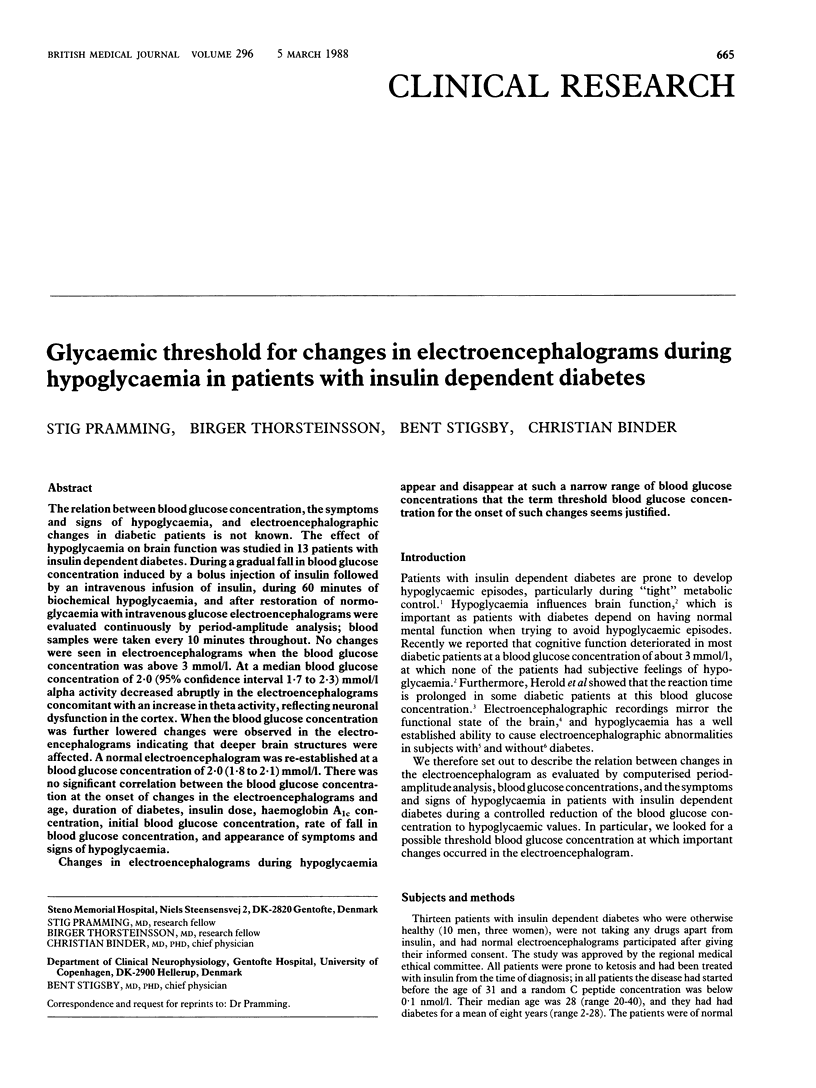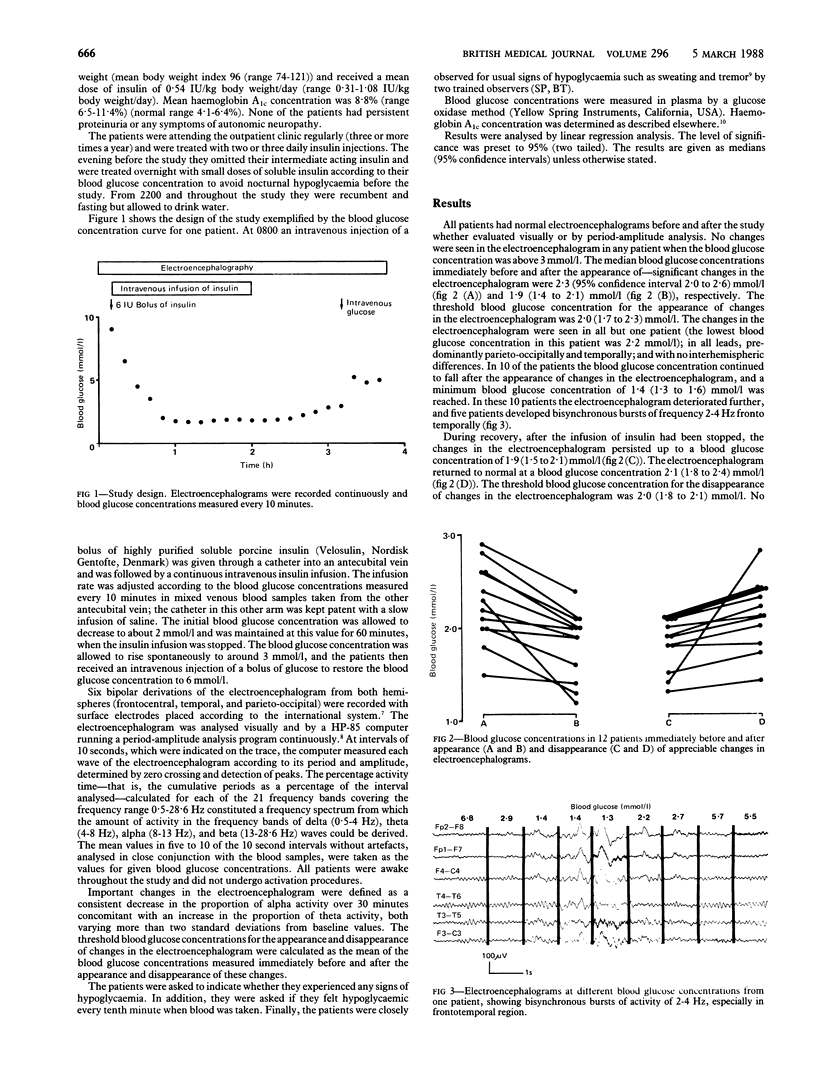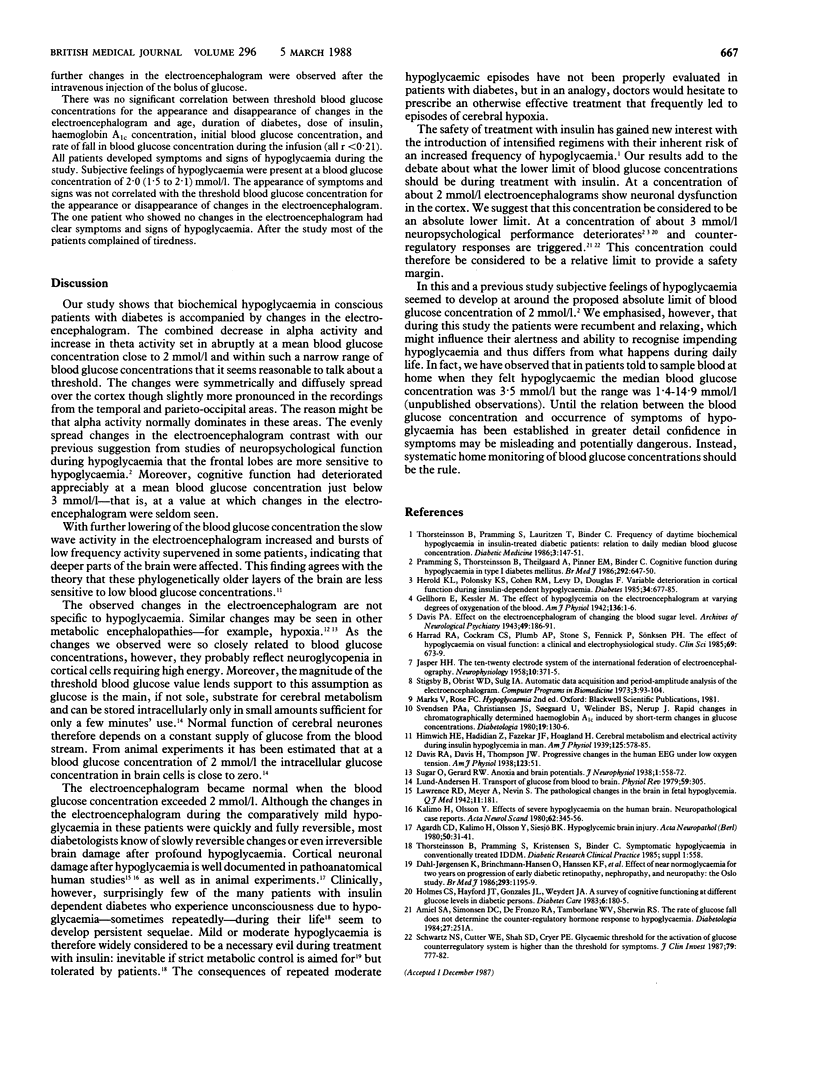Abstract
The relation between blood glucose concentration, the symptoms and signs of hypoglycaemia, and electroencephalographic changes in diabetic patients is not known. The effect of hypoglycaemia on brain function was studied in 13 patients with insulin dependent diabetes. During a gradual fall in blood glucose concentration induced by a bolus injection of insulin followed by an intravenous infusion of insulin, during 60 minutes of biochemical hypoglycaemia, and after restoration of normoglycaemia with intravenous glucose electroencephalograms were evaluated continuously by period-amplitude analysis; blood samples were taken every 10 minutes throughout. No changes were seen in electroencephalograms when the blood glucose concentration was above 3 mmol/l. At a median blood glucose concentration of 2·0 (95% confidence interval 1·7 to 2·3) mmol/l alpha activity decreased abruptly in the electroencephalograms concomitant with an increase in theta activity, reflecting neuronal dysfunction in the cortex. When the blood glucose concentration was further lowered changes were observed in the electroencephalograms indicating that deeper brain structures were affected. A normal electroencephalogram was re-established at a blood glucose concentration of 2·0 (1·8 to 2·1) mmol/l. There was no significant correlation between the blood glucose concentration at the onset of changes in the electroencephalograms and age, duration of diabetes, insulin dose, haemoglobin A1c concentration, initial blood glucose concentration, rate of fall in blood glucose concentration, and appearance of symptoms and signs of hypoglycaemia.
Changes in electroencephalograms during hypoglycaemia appear and disappear at such a narrow range of blood glucose concentrations that the term threshold blood glucose concentration for the onset of such changes seems justified.
Full text
PDF


Selected References
These references are in PubMed. This may not be the complete list of references from this article.
- Agardh C. D., Kalimo H., Olsson Y., Siesjö B. K. Hypoglycemic brain injury. I. Metabolic and light microscopic findings in rat cerebral cortex during profound insulin-induced hypoglycemia and in the recovery period following glucose administration. Acta Neuropathol. 1980;50(1):31–41. doi: 10.1007/BF00688532. [DOI] [PubMed] [Google Scholar]
- Dahl-Jørgensen K., Brinchmann-Hansen O., Hanssen K. F., Ganes T., Kierulf P., Smeland E., Sandvik L., Aagenaes O. Effect of near normoglycaemia for two years on progression of early diabetic retinopathy, nephropathy, and neuropathy: the Oslo study. Br Med J (Clin Res Ed) 1986 Nov 8;293(6556):1195–1199. doi: 10.1136/bmj.293.6556.1195. [DOI] [PMC free article] [PubMed] [Google Scholar]
- Harrad R. A., Cockram C. S., Plumb A. P., Stone S., Fenwick P., Sönksen P. H. The effect of hypoglycaemia on visual function: a clinical and electrophysiological study. Clin Sci (Lond) 1985 Dec;69(6):673–679. doi: 10.1042/cs0690673. [DOI] [PubMed] [Google Scholar]
- Herold K. C., Polonsky K. S., Cohen R. M., Levy J., Douglas F. Variable deterioration in cortical function during insulin-induced hypoglycemia. Diabetes. 1985 Jul;34(7):677–685. doi: 10.2337/diab.34.7.677. [DOI] [PubMed] [Google Scholar]
- Holmes C. S., Hayford J. T., Gonzalez J. L., Weydert J. A. A survey of cognitive functioning at difference glucose levels in diabetic persons. Diabetes Care. 1983 Mar-Apr;6(2):180–185. doi: 10.2337/diacare.6.2.180. [DOI] [PubMed] [Google Scholar]
- Kalimo H., Olsson Y. Effects of severe hypoglycemia on the human brain. Neuropathological case reports. Acta Neurol Scand. 1980 Dec;62(6):345–356. doi: 10.1111/j.1600-0404.1980.tb03047.x. [DOI] [PubMed] [Google Scholar]
- Lund-Andersen H. Transport of glucose from blood to brain. Physiol Rev. 1979 Apr;59(2):305–352. doi: 10.1152/physrev.1979.59.2.305. [DOI] [PubMed] [Google Scholar]
- Pramming S., Thorsteinsson B., Theilgaard A., Pinner E. M., Binder C. Cognitive function during hypoglycaemia in type I diabetes mellitus. Br Med J (Clin Res Ed) 1986 Mar 8;292(6521):647–650. doi: 10.1136/bmj.292.6521.647. [DOI] [PMC free article] [PubMed] [Google Scholar]
- Schwartz N. S., Clutter W. E., Shah S. D., Cryer P. E. Glycemic thresholds for activation of glucose counterregulatory systems are higher than the threshold for symptoms. J Clin Invest. 1987 Mar;79(3):777–781. doi: 10.1172/JCI112884. [DOI] [PMC free article] [PubMed] [Google Scholar]
- Stigsby B., Obrist W. D., Sulg I. A. Automatic data acquisition and period-amplitude analysis of the electroencephalogram. Comput Programs Biomed. 1973 Jul;3(2):93–104. doi: 10.1016/0010-468x(73)90025-1. [DOI] [PubMed] [Google Scholar]
- Svendsen P. A., Christiansen J. S., Søegaard U., Welinder B. S., Nerup J. Rapid changes in chromatographically determined haemoglobin A1c induced by short-term changes in glucose concentration. Diabetologia. 1980 Aug;19(2):130–136. doi: 10.1007/BF00421859. [DOI] [PubMed] [Google Scholar]
- Thorsteinsson B., Pramming S., Lauritzen T., Binder C. Frequency of daytime biochemical hypoglycaemia in insulin-treated diabetic patients: relation to daily median blood glucose concentrations. Diabet Med. 1986 Mar;3(2):147–151. doi: 10.1111/j.1464-5491.1986.tb00726.x. [DOI] [PubMed] [Google Scholar]


